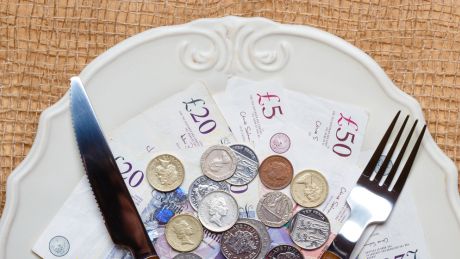
Of all the excuses we use to justify eating junk food, the supposed cost of healthier alternatives is one of the most common – according to a recent survey of 2,000 Brits – closely followed by a shortage of time. But does a lack of funds really have to be a barrier to good nutrition?
The argument goes that buying the fresh ingredients required to make your own meals and snacks is more expensive than the ready-prepared alternatives. That certainly sounds logical. But while it’s true that some fresh produce is pricier, pound for pound – especially if you’re shelling out for nutrient-rich free range or organic options – this doesn’t necessarily have to translate into more expensive meals. So what’s the key to eating healthily without breaking the bank?
The first thing to do is re-stock your freezer. For many of us, buying fresh often leads to a lot of wastage – how many times have you picked up a pack of veg that’s more than enough to make a specific meal and ended up throwing the remainder away because it’s gone off? The solution: embrace frozen fruit and veg. Most major supermarkets now stock iced versions of everything from green beans to strawberries, via mushrooms, carrots, mango and broccoli, often ready-prepped in big, budget-friendly packs that will last for months. Take blueberries – one of the healthiest foods around thanks to their high levels of antioxidants and fat-fighting pterostilbene. A 150g tray of the fresh variety costs £2, which works out at a relatively hefty 66p per 50g serving. But for the same money you can get 350g of frozen – less than half the price at 28p per portion.
What’s more, they’re actually healthier than their fresh counterparts. No, really. Because they’re frozen almost immediately after harvesting, the nutrients are locked in at source. Contrast this with some of the “fresh” food lining our supermarket aisles: it has often travelled halfway around the world and sat on a shelf for days while the nutrients slowly degrade, vastly reducing their health-boosting potential.
A fully stocked freezer will expand your options for what you can cook, but to really make things cost-effective, you’ll also need to rethink how you cook it. A key issue with home-made meals is the cost of all the additional ingredients – on top of the fresh veg and meat – required for most recipes. If you’re only making one or two portions, the cost per serving is going to be fairly high (and lead to more wastage). But if you can scale up the quantity, a lot of the ingredients suddenly become more economical, especially with meals that lend themselves to batch-cooking like chilli con carne or stews. All you then need to do is divide the extra portions into sealed tubs, freeze them and you’ve created your own line of healthy DIY ready meals that’ll last for months and cost significantly less than the supermarket versions (which can sell for anything up to a fiver, come swimming in added salt, sugar and preservatives, and won’t do your waistline any favours).
But the best news? By batch-cooking all your food in advance, you’ll also be sidestepping the other major excuse for eating junk food: a busy schedule. The time to reinvest your savings in a bigger freezer is now.
The bottom line Healthy eating doesn’t have to be expensive, provided you batch-cook your meals and use frozen fruit and veg. If anything, it can actually save you money.
Get the Coach Newsletter
Sign up for workout ideas, training advice, reviews of the latest gear and more.
Smart swaps
These healthy upgrades won’t cost you any more than the processed alternatives, but they will make your diet healthier
Porridge oats for breakfast cereal
Unlike cereal, porridge is packed with muscle-building protein, filling fibre and low-GI carbohydrates that will help to sustain your energy levels throughout the morning. Plus, you’ve got countless healthy toppings to keep it interesting.
RECOMMENDED: Healthy Breakfasts
Peanut butter for chocolate spread
While no less indulgent than chocolate spread, peanut butter is much better for you, thanks to its high levels of heart-healthy monounsaturated fat and protein. It goes amazingly with your morning fruit smoothie, too.
RECOMMENDED: Peanut Butter Recipes
Greek yogurt for fruit yogurt
Greek yogurt contains around twice as much protein as regular yogurt and half the carbs. Better still, it’s low in fat and free from the added sugar and sweeteners often found in fruit yogurts. Add berries, and you’ve got a delicious, healthy dessert.
Dark chocolate for milk chocolate
Chocolate? Healthy? Yep – when it’s of the dark variety. Dark chocolate is crammed with antioxidants and boost your levels of compounds such as tryptophan, serotonin and dopamine (the so-called “happy hormone” that boosts your mood). And choose quality stuff with a high cocoa content – most supermarket own-brand varieties are just as ropey as the sugar-packed milk options.
Wholegrain rye bread for white bread
This dark, grainy loaf will drip-feed you energy throughout the day, filling you up and helping you avoid hunger pangs. “Mighty” white on the other hand is highly processed and more likely to spike your blood sugar levels, which can lead to fat storage. Rye lasts far longer in your bread bin, too.
Between 2010 and 2016, Ben was the deputy editor of Men’s Fitness UK, which predated, and then shared a website with, Coach. Ben also contributed exclusive features to Coach on topics such as football drills, triathlon training plans and healthy eating.

